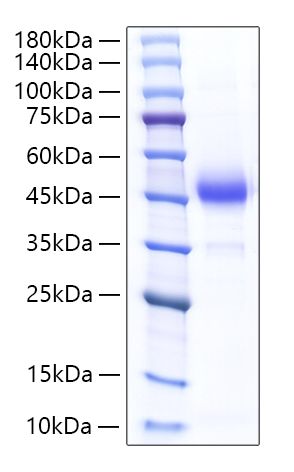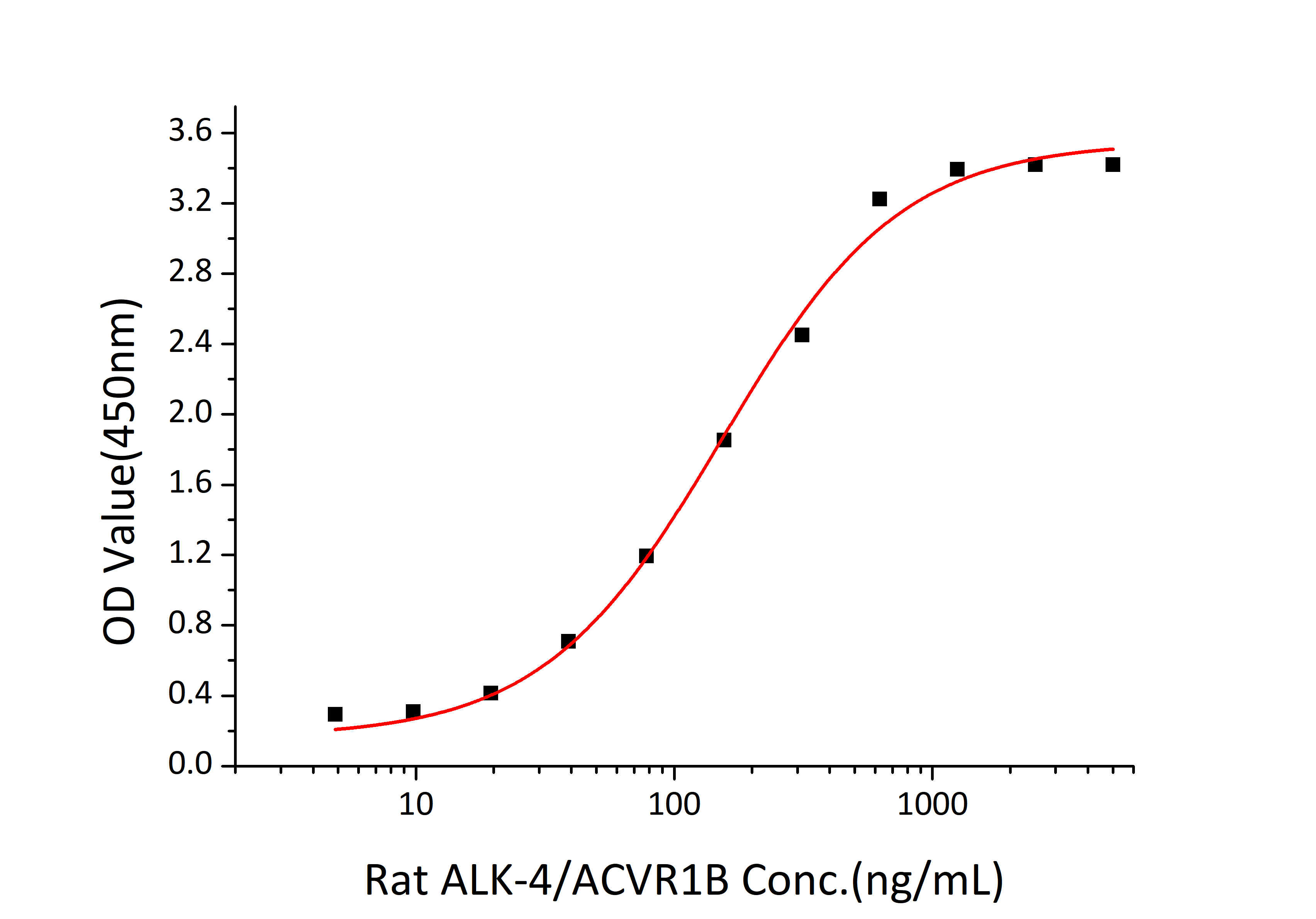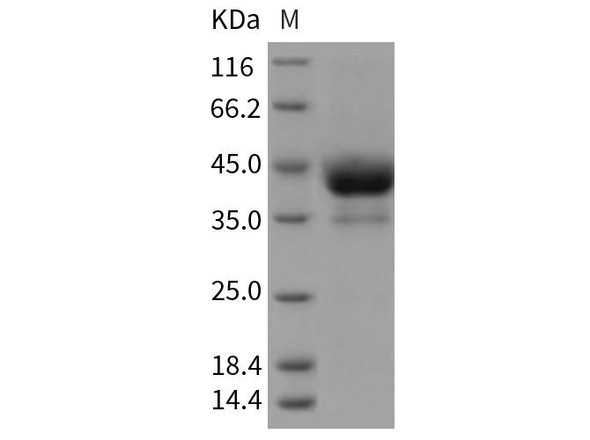Description
Recombinant Rat ALK-4/ACVR1B Protein
The Recombinant Rat ALK-4/ACVR1B Protein is a high-quality recombinant protein produced for advanced research applications in molecular biology and biotechnology. This protein serves as a critical reagent in various experimental contexts, including functional studies, binding assays, and therapeutic development programs, providing researchers with a standardized and reliable tool for investigating protein function and interactions.
This product (SKU: RPCB1224) is produced using advanced expression systems and features a C-hFc tag for convenient detection and purification. The protein exhibits a calculated molecular weight of 41.35 kDa with an observed molecular weight of 45-50 kDa under denaturing conditions, achieving ≥ 90% as determined by SDS-PAGE.. Functional bioactivity has been validated through rigorous quality control assays, confirming its suitability for demanding research applications.
Key Features
| High Purity by Affinity Chromatography | |
| Mammalian & Bacterial Expression Systems | |
| High lot-to-lot consistency via strict QC |
| Product Name: | Recombinant Rat ALK-4/ACVR1B Protein |
| SKU: | RPCB1224 |
| Size: | 10 μg , 20 μg , 50 μg , 100 μg |
| Reactivity: | Rat |
| Synonyms: | Activin receptor type-1B, 2.7.11.30, Activin receptor type IB, ACTR-IB, Activin receptor-like kinase 4, ALK-4, Serine/threonine-protein kinase receptor R2, SKR2,Acvr1b, Acvrlk4, Alk4 |
| Tag: | C-hFc |
| Calculated MW: | 41.35 kDa |
| Observed MW: | 45-50 kDa |
| Gene ID: | 29381 |
| Protein Description: | High quality, high purity and low endotoxin recombinant Recombinant Rat ALK-4/ACVR1B Protein (RPCB1224), tested reactivity in HEK293 cells and has been validated in SDS-PAGE.100% guaranteed. |
| Endotoxin: | < 0.1 EU/μg of the protein by LAL method. |
| Purity: | ≥ 90% as determined by SDS-PAGE. |
| Formulation: | Lyophilized from a 0.22 μm filtered solution of PBS, pH 7.4. |
| Bio-Activity: | Measured by its binding ability in a functional ELISA. Immobilized human Cripto-1/TDGF1 protein(RPCB0341) at 2μg/mL (100 μL/well) can bind rat ALK-4/ACVR1B with a linear range of 4.9-152.7 ng/mL. |
| Reconstitution: | Centrifuge the vial before opening. Reconstitute to a concentration of 0.1-0.5 mg/mL in sterile distilled water. Avoid vortex or vigorously pipetting the protein. For long term storage, it is recommended to add a carrier protein or stablizer (e.g. 0.1% BSA, 5% HSA, 10% FBS or 5% Trehalose), and aliquot the reconstituted protein solution to minimize free-thaw cycles. |
| Storage: | Store at -20℃.Store the lyophilized protein at -20℃ to -80 ℃ up to 1 year from the date of receipt. After reconstitution, the protein solution is stable at -20℃ for 3 months, at 2-8℃ for up to 1 week. |
Activin RIB, also known as activin receptor type-1B (ACVR1B) or ALK-4, is a type I transmembrane serine/threonine kinase receptor that is part of the TGF-β receptor superfamily. Activin binds to a type II activin receptor (ACVR2or ACVR2B) and then recruits ACVR1B. ALK4 is an important regulator of vertebrate development, with roles in mesoderm induction, primitive streak formation, gastrulation, dorsoanterior patterning, and left-right axis determination. The sequence of amino acids in ALK4 (ACVR1B) proteins from different species is very stable, which leads to the conclusion that in the process of evolution, ALK4 has been only slightly altered, and that both in humans and in animals, its function is similar. ALK4 (ACVR1B) forms an activin receptor complex with activin type-II receptor to transduce activin signal from the cell surface to the cytoplasm, thus regulating physiological and pathological processes including embryogenesis, tissue homeostasis, wound healing, extracellular matrix production, immunosuppression, and carcinogenesis. Receptor heterodimerization activates the type II receptor kinase to phosphorylate the type I receptor, which recruits and phosphorylates regulated Smads2 and 3. Phosphorylated regulated Smads are released and form a heteromeric complex with the Co-Smad, Smad4. The regulated Smad and Co-Smad complex then translocates to the nucleus where it regulates the expression of many genes. In mammals, Acvr1b is expressed by various types of epithelial cells, including interfollicular epidermis, and the outer root sheath (ORS) and the inner root sheath (IRS) of the hair follicles. Activin signaling through Acvr1b acts on skin epithelial cells in a paracrine manner.








